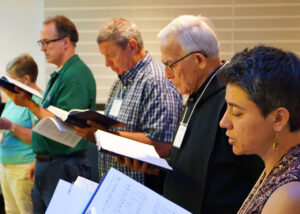I stopped short when the ’70s picture of a serious-looking white-haired man in a suit and tie popped up on my screen.
I had started an article about a Mennonite thinker and institution builder who died before I had a chance to meet him. Part-way through my research I stumbled upon his photo. It was pretty much the standard posed headshot I would have expected had I thought about it, but still, when confronted with the image, I knew the article was dead.
My reaction was partly a capitulation to the anti-authority bias in vogue for the past generation. Old white male big shots have a bad rap. But it wasn’t so much the old or white or male aspects themselves that bothered me. I semi-regularly find myself referring in day-to-day conversation to the white male elders who have been, and continue to be, invaluable in my life. My reaction was more to the way in which those three elements sometimes create a particular concoction of authority that has indelibly shaped the church.
I am grateful to those who helped build the institutions I have benefitted from. Many leaders were leaders for good reason. They had innovative ideas and earned authority. But that’s not the whole story. Many people have experienced exclusion in various ways and to varying degrees. And our institutions would feel different had others been more involved.
At a gut level I’m more interested in the stories of people on the creative fringes—the excluded ones—than those with institutional legacies. The tension between the two is important.
Which stories and voices do we privilege? I reviewed a year’s worth of this magazine, noting which voices get published. I also looked at the leadership demographics of 12 Mennonite organizations.
The easiest thing to note is gender balance. In the past year, about 340 pages of this magazine were written by men, and about 320 by women. The stats are imprecise and incomplete. Many articles cover parts of pages so I rounded off. And an article by a woman about a man counted in the woman column.
A glance back to 1997, when the current incarnation of Canadian Mennonite began, shows the gender balance has been relatively constant, although then, like now, men wrote a lot more letters. In the last year, men wrote 120 letters compared to 49 by women.
Again, these are only rough indicators. It’s dangerous to read too much—or too little—into them.
In terms of ethnicity, only a handful of people recognizably from an ethnic minority wrote articles or letters in the past year, although numerous articles were written about such people and included their voices in one way or another. Ten of 24 covers featured non-Caucasian people.
Age is harder to assess, although certainly the Young Voices section in Canadian Mennonite adds some conspicuous and needed balance.
In terms of leadership in Mennonite organizations—including this publication, Mennonite Church Canada, Mennonite Central Committee offices in Canada, Mennonite World Conference (MWC), and three post-secondary schools—the numbers show that men make up 60 percent of boards, 58 percent of board chairs and two thirds of executive directors or presidents. There is a distinguishable bias, but no glass ceiling. The numbers 20 years ago would have been different.
I suspect the age gap on these boards would be considerable. And white people generally run the show, with the exception of MWC. One could also look at sexual identity, people with disabilities and rural inclusion.
One finding that sticks out for me, and circles round to my original stumbling block, is that 11 of the 13 obituaries published in this magazine in the past year paid tribute to men. (This does not reflect an intent on the part of editors—that’s not how magazines are made—it is just what happened.)
Of course, every life is worthy of note; that’s part of the principle behind inclusion and embrace of diversity. We need to be attentive to which stories and over-arching narratives make their way to the surface. And which don’t. Do achievement and success dominate? Do we publicly affirm the stories of little people? Who do we hold up as leaders?
We have made significant improvements. Of course, many people still feel excluded and hurt. We must mark positive change without using it as an excuse to stop striving.
The Old Testament encourages us to sing a new song. The New Testament steers us hard toward the lesser, the least and the powerless. We need leaders who point us in that direction and we all need to look to the margins to lead us.







Leave a Reply
You must be logged in to post a comment.